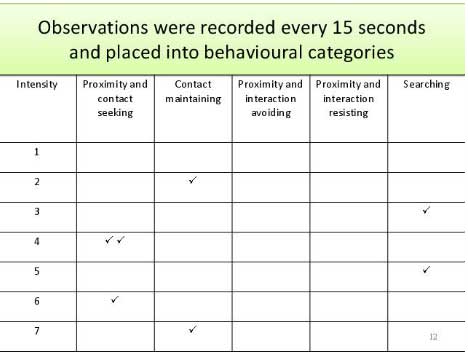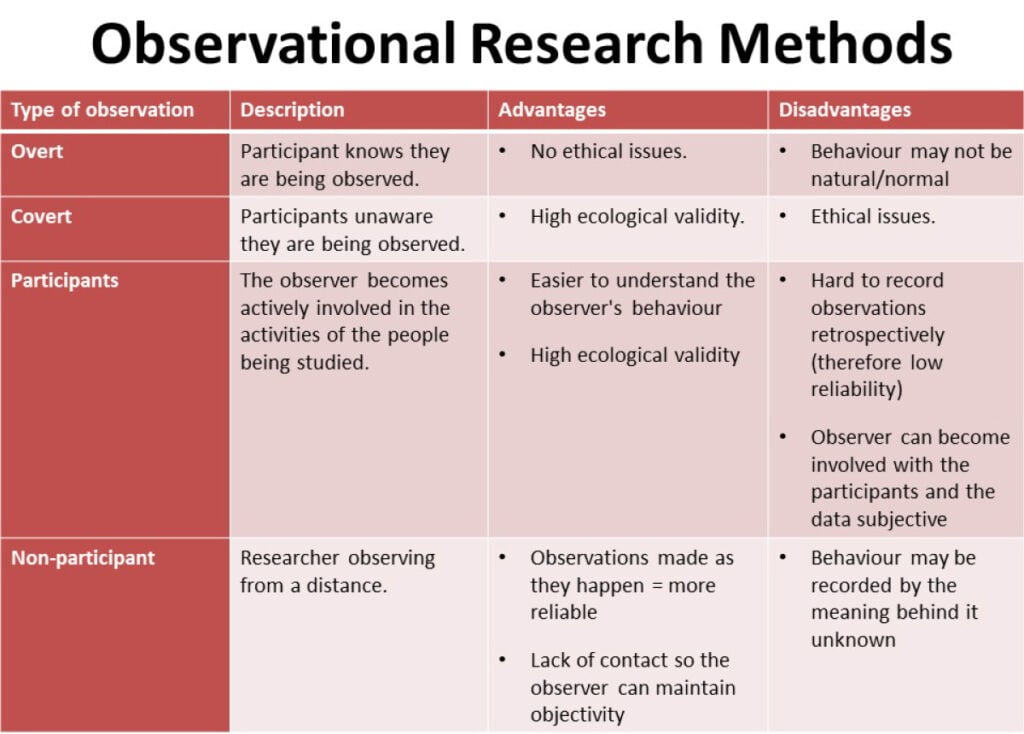On This Page:
Observation (watching what people do) would seem to be an obvious method of carrying out research in psychology. However, there are different types of observational methods, and distinctions need to be made between:
1. Controlled Observations
2. Naturalistic Observations
3. Participant Observations
In addition to the above categories, observations can also be either overt/disclosed (the participants know they are being studied) or covert/undisclosed (the researcher keeps their real identity a secret from the research subjects, acting as a genuine member of the group).
In general, observations are relatively cheap to carry out, and the researcher needs few resources. However, they can often be very time-consuming and longitudinal.
Controlled Observation
Controlled observation is a research method for studying behavior in a carefully controlled and structured environment.
The researcher sets specific conditions, variables, and procedures to systematically observe and measure behavior, allowing for greater control and comparison of different conditions or groups.
The researcher decides where the observation will occur, at what time, with which participants, and in what circumstances, and uses a standardized procedure. Participants are randomly allocated to each independent variable group.
Rather than writing a detailed description of all behavior observed, it is often easier to code behavior according to a previously agreed scale using a behavior schedule (i.e., conducting a structured observation).
The researcher systematically classifies the behavior they observe into distinct categories. Coding might involve numbers or letters to describe a characteristic or the use of a scale to measure behavior intensity.
The categories on the schedule are coded so that the data collected can be easily counted and turned into statistics.
For example, Mary Ainsworth used a behavior schedule to study how infants responded to brief periods of separation from their mothers. During the Strange Situation procedure infant’s interaction behaviors directed toward the mother were measured, e.g.
- Proximity and contacting seeking
- Contact maintaining
- Avoidance of proximity and contact
- Resistance to contact and comforting
The observer noted down the behavior displayed during 15-second intervals and scored the behavior for intensity on a scale of 1 to 7.

Sometimes the behavior of participants is observed through a two-way mirror, or they are secretly filmed. Albert Bandura used this method to study aggression in children (the Bobo doll studies).
A lot of research has been carried out in sleep laboratories as well. Here electrodes are attached to the scalp of participants. What is observed are the changes in electrical activity in the brain during sleep (the machine is called an electroencephalogram – an EEG).
Controlled observations are usually overt as the researcher explains the research aim to the group so the participants know they are being observed.
Controlled observations are also usually non-participant as the researcher avoids any direct contact with the group, keeping a distance (e.g., observing behind a two-way mirror).
Strengths
- Controlled observations can be easily replicated by other researchers by using the same observation schedule. This means it is easy to test for reliability.
- The data obtained from structured observations is easier and quicker to analyze as it is quantitative (i.e., numerical) – making this a less time-consuming method compared to naturalistic observations.
- Controlled observations are fairly quick to conduct which means that many observations can take place within a short amount of time. This means a large sample can be obtained, resulting in the findings being representative and having the ability to be generalized to a large population.
Limitations
- Controlled observations can lack validity due to the Hawthorne effect /demand characteristics. When participants know they are being watched, they may act differently.
Naturalistic Observation
Naturalistic observation is a research method in which the researcher studies behavior in its natural setting without intervention or manipulation.
It involves observing and recording behavior as it naturally occurs, providing insights into real-life behaviors and interactions in their natural context.
Naturalistic observation is a research method commonly used by psychologists and other social scientists.
This technique involves observing and studying the spontaneous behavior of participants in natural surroundings. The researcher simply records what they see in whatever way they can.
In unstructured observations, the researcher records all relevant behavior without a system. There may be too much to record, and the behaviors recorded may not necessarily be the most important, so the approach is usually used as a pilot study to see what type of behaviors would be recorded.
Compared with controlled observations, it is like the difference between studying wild animals in a zoo and studying them in their natural habitat.
With regard to human subjects, Margaret Mead used this method to research the way of life of different tribes living on islands in the South Pacific. Kathy Sylva used it to study children at play by observing their behavior in a playgroup in Oxfordshire.
Strengths
- By being able to observe the flow of behavior in its own setting, studies have greater ecological validity.
- Like case studies, naturalistic observation is often used to generate new ideas. Because it gives the researcher the opportunity to study the total situation, it often suggests avenues of inquiry not thought of before.
Limitations
- These observations are often conducted on a micro (small) scale and may lack a representative sample (biased in relation to age, gender, social class, or ethnicity). This may result in the findings lacking the ability to generalize to wider society.
- Natural observations are less reliable as other variables cannot be controlled. This makes it difficult for another researcher to repeat the study in exactly the same way.
- A further disadvantage is that the researcher needs to be trained to be able to recognize aspects of a situation that are psychologically significant and worth further attention.
- With observations, we do not have manipulations of variables (or control over extraneous variables), meaning cause-and-effect relationships cannot be established.
Participant Observation
Participant observation is a variant of the above (natural observations) but here, the researcher joins in and becomes part of the group they are studying to get a deeper insight into their lives.
If it were research on animals, we would now not only be studying them in their natural habitat but be living alongside them as well!
Leon Festinger used this approach in a famous study into a religious cult that believed that the end of the world was about to occur. He joined the cult and studied how they reacted when the prophecy did not come true.
Participant observations can be either cover or overt. Covert is where the study is carried out “undercover.” The researcher’s real identity and purpose are kept concealed from the group being studied.
The researcher takes a false identity and role, usually posing as a genuine member of the group.
On the other hand, overt is where the researcher reveals his or her true identity and purpose to the group and asks permission to observe.
Limitations
- It can be difficult to get time/privacy for recording. For example, researchers can’t take notes openly with covert observations as this would blow their cover. This means they must wait until they are alone and rely on their memory. This is a problem as they may forget details and are unlikely to remember direct quotations.
- If the researcher becomes too involved, they may lose objectivity and become biased. There is always the danger that we will “see” what we expect (or want) to see. This problem is because they could selectively report information instead of noting everything they observe. Thus reducing the validity of their data.
Recording of Data
With controlled/structured observation studies, an important decision the researcher has to make is how to classify and record the data. Usually, this will involve a method of sampling. The three main sampling methods are:
- Event sampling. The observer decides in advance what types of behavior (events) she is interested in and records all occurrences. All other types of behavior are ignored.
- Time sampling. The observer decides in advance that observation will occur only during specified time periods (e.g., 10 minutes every hour, 1 hour per day) and records the occurrence of the specified behavior during that period only.
- Instantaneous (target time) sampling. The observer decides in advance the pre-selected moments when observation will occur and records what is happening at that instant. Everything happening before or after is ignored.


